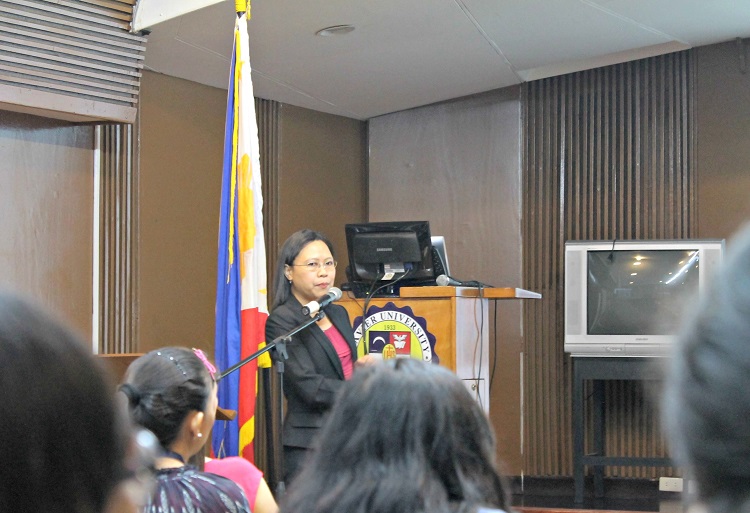HOMEGROWN. Georgetown scientist Dr Janeth B Presores visits her alma mater Xavier University to take part in the lecture series of XU Chemistry Department. She talks on the adhesion properties and transformation processes of uric acid crystals.
By Stephen J Pedroza
At least six different crystalline phases of uric acid, a product of protein metabolism, have been identified in human kidney stones, a surface analysis expert said.
Dr Janeth B Presores, a faculty member of the Department of Chemistry at Georgetown University, presented the findings of her research titled “Uric Acid Crystals: Adhesion Properties and Phase Transformations” during the lecture dubbed “Stone, Stone Go Away” on June 22 at Xavier University’s AVR1.
Central to her research is the study of the two forms of uric acid: anhydrous uric acid (UA) and uric acid dihydrate (UAD). UA is the most abundant uric acid in kidney stones followed by UAD. These crystals are characterized to understand crystal nucleation, growth, aggregation, and adhesion phenomena related to the formation of kidney stones in the human body.
Uric acid stones may form in people who eat a high-protein diet and those who have a high supersaturation of uric acid in urine. Three underlying factors responsible for uric acid nephrolithiasis are low urine pH, hyperuricosuria (elevated uric acid in urine), and low urine volume.
Studies have also shown that certain genetic factors also may aggravate the risk of uric acid stones.
A person with kidney stones may experience, among others, severe pain in the side, back, below the ribs, lower abdomen, and groin; pain that comes in waves and fluctuates in intensity; and pain on urination (pink, red or brown urine and foul-smelling urine).
She said that the two key steps in kidney stone formation — crystal aggregation and attachment to renal tissues — depend on the surface adhesion properties of the crystalline components.
Using chemical force microscopy, Presores measured the adhesion force between various functional groups and the largest (100) surface of UA single crystals in both aqueous (distilled water) solution and model urine. She found out that adhesion trends in the two solutions were identical but consistently lower in the latter. In both solutions, the adhesion force is highest with the cationic surfaces and the (100) surface of UA. Other solution parameters such as ionic strength and pH level were influential in the magnitude of the adhesion.
Presores also presented the results of the phase transformations of UAD to UA as a function of pH as well as in model urine solution. UAD transformed to UA via a two-step process; metastable UAD undergoes dissolution followed by nucleation and growth of the stable UA. The timescale of the process suggests that metastable UAD precipitated under physiologic conditions is an important intermediate in the pathology of uric acid stones, regardless of whether the UAD phase is present in the final renal deposits.
After her discussion, Presores answered the questions of XU faculty, staff and students during the open forum.
“I hope that with what this study has found out, other branches of science, especially the medical science can produce drugs that will prevent the formation of kidney stones,” Presores said, adding that there are available drugs already in the market to treat those with kidney stones.
“Drink plenty of fluids and avoid eating fatty food,” she warned.
Presores is a chemistry graduate from Xavier University in 1992 and she taught at XU Chemistry Department for two years. She then pursued MS in Chemistry at the Ateneo de Manila University under the faculty development program of Xavier, supported by Fund for Assistance to Private Education and DOST-ESEP Scholarship Fund.
“It is a rare occasion that we get a chance to hear from an expert in the field of surface analysis, including the highly specialized area of x-ray crystallography,” said Dr Heide R Rabanes, a Xavier colleague of Presores.
“This is also an inspiring occasion for all of us because our speaker is a homegrown ‘talent,’ having graduated from our own BS Chemistry program here at Xavier University and yet has managed to infiltrate the high caliber circle of students and faculty of Georgetown University in Washington DC, USA,” Rabanes added.
In August of 2005, she moved to the United States to begin her doctoral study at Georgetown University. While working on her dissertation, she served as a teaching assistant in Organic Chemistry and she supervised research studies of undergraduate students.
After obtaining her PhD in Chemistry in 2012, she then joined the Jesuit-run Georgetown University as a faculty member of their Department of Chemistry. ∎

